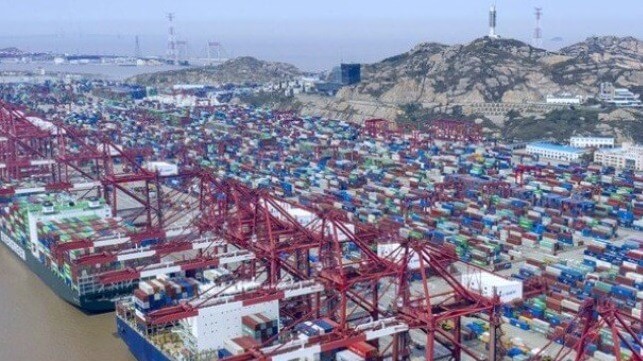Freight Rates Declining in 2022 in the Face of Uncertainties

After a year in which freight rates continued to set new highs, spot rates are on the decline in 2022 with experts pointing to a series of factors likely contributing to an ongoing decline. The steady drop that began in January is continuing with many experts questioning if rates have peaked due to lower demand even before the industry’s massive new building efforts begin to provide the expected dramatic increases in capacity late in 2023 and beyond.
“We have seen a sharp decline in freight rates in the last three months due to a decrease in sales and full inventories as we enter the traditional post-Chinese New Year lean season,” said Shabsie Levy, CEO and Founder of Shifl, a technology platform helping shippers plan and manage their supply chain. According to their analysis, trans-Pacific container spot rates between China and the U.S.’s East and West coast ports are down by half between January and March 2022.
The Drewry World Container Index bears out the trend demonstrating that the same factors are at play on a global basis. Last week, they reported that while rates are still up by two-thirds over a year ago, the global spot rate average was down nearly four percent for the week. Freight rates on transpacific routes they noted declined for the fifth consecutive week, with prices to the U.S. down anywhere between six and eight percent, with a smaller one to two percent decline to Europe. Further, in the past month, container shipping costs overall have fallen by about 12 percent, according to the Drewry World Container Index.
While the drop in spot freight rates due to reduced volumes and inflation is more prevalent in the U.S., Shifl China’s offices also point to recent COVID-19 lockdowns in major Chinese manufacturing hubs that are also contributing to the decline. China has been moving through a series of rolling lockdowns around different parts of the country, impacting northern ports late in 2021 followed by closures around Ningbo early in 2022. However, the most significant and concerning lockdown is ongoing and being extended in Shanghai, home to the world’s busiest container port.
Officials from the Shanghai International Port Group and the Chinese government insist that the port continues to operate normally denying reports of growing backlogs. The state media China Daily quoted a port official refuting reports of 300 or more ships waiting offshore saying it was currently around 50 vessels. He stated that the port had handled 396 vessels last week near its maximum of 400. Some shipping companies such as Maersk are also reporting that they have so far not canceled any sailings while there are however indications of increasing blanked sailing and rerouted ships. Lloyd’s Intelligence however calculated that as of April 4, 140 containerships are waiting outside the ports of Shanghai and nearby Ningbo.
While the terminals in Shanghai are officially open, trucking capacity is dramatically limited with drivers required to provide negative COVID tests to move around the city and enter the port area. Further many factories remain closed reducing the flow of goods to the port and in turn reducing demand for the ships.
The decline in demand is also showing up at other points in the supply chain. The Marine Exchange of Southern California for example reported that the number of containerships waiting for berth space at the twin southern California ports reached a new low at the beginning of this week. The number of containerships fell to just 33 vessels on April 4, down by more than two-thirds from the peak in January.
Other factors are also contributing to the declines in demand which are in turn driving freight rates lower. Consumer spending appears to be returning to more typical pre-COVID levels as people have resumed more normal daily routines while strong inflation and higher gasoline prices also caused consumers to cut back on discretionary spending. Similarly, high fuel prices drove up trucking and other costs prompting retailers and others to further slow their orders to control costs.
“We expect the rates to continue their downward trend up to the 2022 peak season at which time the rates will go up, albeit not to the levels seen in 2021” predicts Levy. “Shippers must plan their inventory and order placements,” warns Levy recommending that they remain wary of committing to fixed long-term rates at current levels.
Shifl also warns that some of the current issues might contribute to a new supply chain storm and rate fluctuations. They point to the likely backlog of goods piling up in China with the potential for a new onslaught to the U.S. West Coast ports when operations head back to normal in China. Further, they point to the potential for further disruptions impacting freight rates suggesting that the return to normalcy in Chinese operations might coincide with the ILWU longshoremen contract negotiations due to start next month in anticipation of their contract expirations this summer. Shippers and carriers have already begun to worry about the potential for disruptions at the West Coast ports and how that might impact freight rates.
